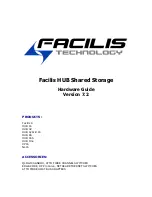
l
Where to move the workload if the array cannot meet the requested service level
If the workload type (OLTP, DSS, replication) is known, the storage administrator can
optionally provide that information with a single mouse click. This additional
information allows FAST to refine response expectations even more accurately.
To provision storage, administrators simply select devices sizes and appropriate
Service Level.
Service Levels are applied to storage groups. If sub-storage groups are configured,
Service Levels can apply to all LUNs/volumes in the storage group, or to a subset of
LUNs (as long as the subset is in a storage group). The database of an application can
use a different Service Level than the logs for that application.
Setting an explicit Service Level on a storage group is optional. If no Service Level is
specified, LUNs/volumes in the storage group use the default: Optimized. Optimized
manages the data to make the most efficient use of the disk resources.
The pre-configured Service Levels cannot be modified.
on page 89 lists the VMAX3 Service Levels:
Table 38 Service Levels
Service Level
Performance type
Use case
Diamond
Ultra high
HPC, latency sensitive
Platinum
Very high
Mission critical, high rate
OLTP
Gold
High
Very heavy I/O, Database
logs, data sets
Silver
Price/Performance
Database data sets, virtual
applications
Bronze
Cost optimized
Backup, archive, file
Optimized (default)
No Service Level is defined.
The most active data is placed
on the highest performing
storage. The least active data
is placed on the most cost-
effective storage.
a. Not supported on storage groups containing CKD volumes.
FAST/SRDF coordination
Symmetrix Remote Data Facility (SRDF) replicates data between 2, 3 or 4 arrays
located in the same room, on the same campus or thousands of kilometers apart. The
read workload is only on the production side of the link, and the remote side may not
be ready to meet the Service Level of a storage group in an event of a failover. FAST/
SRDF coordination considers the entire workload profile at the production site, and
provides the remote array all the information it needs in the event of a failover. This
allows the remote site to better meet the Service Level of the storage group.
on page 163 provides more information.
Storage Tiering
FAST/SRDF coordination
89
Содержание VMAX 100K
Страница 1: ...EMC VMAX3 Family Product Guide VMAX 100K VMAX 200K VMAX 400K with HYPERMAX OS REVISION 6 5 ...
Страница 20: ...Preface 20 Product Guide VMAX 100K VMAX 200K VMAX 400K with HYPERMAX OS ...
Страница 46: ...VMAX3 with HYPERMAX OS 46 Product Guide VMAX 100K VMAX 200K VMAX 400K with HYPERMAX OS ...
Страница 72: ...Open systems features 72 Product Guide VMAX 100K VMAX 200K VMAX 400K with HYPERMAX OS ...
Страница 82: ...Provisioning 82 Product Guide VMAX 100K VMAX 200K VMAX 400K with HYPERMAX OS ...
Страница 100: ...Native local replication with TimeFinder 100 Product Guide VMAX 100K VMAX 200K VMAX 400K with HYPERMAX OS ...
Страница 158: ...Remote replication solutions 158 Product Guide VMAX 100K VMAX 200K VMAX 400K with HYPERMAX OS ...
Страница 186: ...Mainframe Error Reporting 186 Product Guide VMAX 100K VMAX 200K VMAX 400K with HYPERMAX OS ...
Страница 200: ...Licensing 200 Product Guide VMAX 100K VMAX 200K VMAX 400K with HYPERMAX OS ...
















































